Waukesha Christmas-Parade Trial, Day Three
Anastasia Katz, American Renaissance, October 11, 2022
On Monday, the trial of the Waukesha Christmas Parade killer resumed. Darrell Brooks faces life in prison for driving his car through a Christmas parade on November 21, 2021, injuring more than 60 white people and killing six. The parade is a 60-year-old tradition in Waukesha, held every year on the Sunday before Thanksgiving.
Mr. Brooks originally entered a plea of “not guilty by reason of mental disease or defect” but withdrew that plea and decided to represent himself in court. Self-representation is a Sixth-Amendment right, established in Faretta v. California.
When the trial started last week, Mr. Brooks came to court wearing an orange prison uniform, even though he had been provided a suit. He was so disruptive that Judge Jennifer Dorow had him removed several times to an adjacent courtroom, where he could participate remotely, but where she could mute his microphone when he talked nonsense.
On Monday, Mr. Brooks came to court dressed appropriately for the first time, and he began by apologizing:
I would like to issue the court an apology from me, in regards to my actions last week during the trial. I just want the court to understand it’s very emotional right now. . . Not to excuse my actions. I should carry myself with better respect; I wasn’t raised that way. . . I owe you, Your Honor, and the court an apology, and I want to stand up as a man and tell the whole court that I apologize to the bailiffs, I apologize for my actions. . . .
Mr. Brooks’ mother has decided not to attend the trial, but his saying “I wasn’t raised that way,” raises the question of whether she is following it and may have told her son to behave himself.
Early in the day, Mr. Brooks had a victory in acting as his own attorney. He had pointed out to the judge that in a video shown in court last week, his ex-girlfriend Erika Patterson can be heard saying that Brooks had tried to run her over with his car the day before the Christmas parade. It had been decided that this would not be discussed during the trial, with testimony limited to his attempt to run her over on the day of the parade. Judge Dorow told the jury to disregard what they heard on the video.
Detective Thomas Casey had testified for the state on Friday, and Mr. Brooks cross-examined him. Mr. Brooks again asked broad, open-ended questions that can result in answers that hurt him. He asked the detective if he remembered any disturbances on the afternoon in question. “You mean when you drove through the parade?” Det. Casey answered.
CASEY
Mr. Brooks rephrased by asking what happened at about 4:30 pm. The detective said, “I heard a horn beeping, and then a Ford Escape came through the parade route, and you drove past me and wouldn’t stop, and you continued driving into the parade route.”
“Who is you?” Brooks asked.
“Darrell Brooks, the defendant, seated at the table.”
Mr. Brooks said, “Let the record show, I do not identify by that name, nor do I know anyone by that name.”
Judge Dorow said the objection was noted. Mr. Brooks brought this up again with other witnesses, whenever they mentioned his name. When he objected to the use of his name, the judge overruled. He also objected once when District Attorney Susan Opper referred to him using the pronoun “he.” Although he objected to “he,” Mr. Brooks did not offer a preferred pronoun. He may be planning to take identity ideology to an extreme, and hopes he will be let off the hook by not identifying as himself.
Mr. Brooks asked Det. Casey how fast he estimated the red SUV was going, and the response was that when he tried to stop the car, it was going three to five miles per hour. Mr. Brooks asked if that was not very fast, and the detective said, “I think it’s very fast when you’re on a parade route, when there’s hundreds of people marching in the road and a police officer is pounding on your hood trying to get the vehicle to stop. Any speed is too fast when you have all those people in the roadway.”
Mr. Brooks is trying to convince the jury that as he drove through the parade route, he honked his horn to warn people to get out of the way. He asked every witness if he heard the horn. Det. Casey testified that he heard the SUV’s horn after it passed him, and Waukesha PD officer Bryce Butran heard the horn, too, but none of the other witnesses did. He asked the high school band director Sarah Wehmeier-Aparicio if music from the marching band covered up the sound of the horn, but she did not think so. When videos were played in court, Mr. Brooks asked so many repetitive questions about whether witnesses heard a car horn that the judge had to tell him to move on. He replayed one video, asking a witness if she heard a horn, but all that could be heard was screams of “Oh, my God!” Mr. Brooks said he could hear the horn, but Judge Dorow told him that he could not testify.
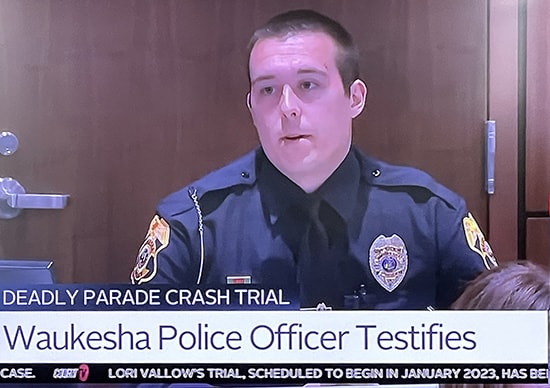
Officer Bryce Butran
Mr. Brooks is also raising the possibility that the tinted windows on his car obscured the view so that witnesses could not identify him. When asked, some witnesses said they noticed tinted rear windows.
He asked them all if they saw the driver and if so, what he looked like. If he was trying to suggest that there was some doubt as to whether he was the driver, it was eliminated during the testimony of Mrs. Wehmeier-Aparicio, when the prosecution showed a still photo of the red SUV driving through the parade. Mr. Brooks’ face was clearly visible through the SUV’s open window.
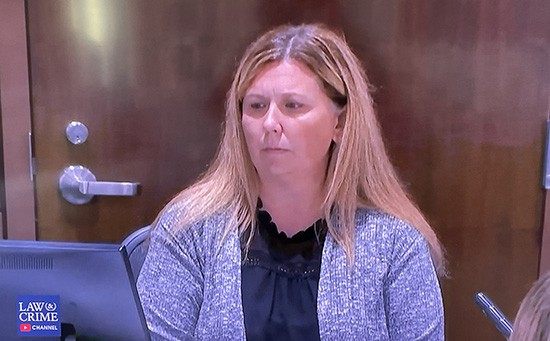
Sarah Wehmeier-Aparicio
From the beginning of the trial, the defendant has been using a strange line of questioning. He has asked witnesses about “the plaintiff,” which would be the party who brings a lawsuit in a civil trial. Questions about “the plaintiff” continued today, starting with Det. Casey. Mr. Brooks asked if he had seen the criminal complaint and who made it. Det. Casey said the complaint was brought by the state of Wisconsin. Mr. Brooks had Det. Casey confirm that that would make the state of Wisconsin the “plaintiff” in the case.
“Do you see the state of Wisconsin in the courtroom right now?” Brooks asked.
“Yes, I do,” Det. Casey replied, “They are represented at the prosecution table.”
“You say they are represented. Do you see the plaintiff?” Mr. Brooks asked.
“The plaintiff is an entity. They are represented by the district attorney’s office.”
“So, the plaintiff is an entity? Is the entity a human being?”
Det. Casey said, “No.”
Mr. Brooks seems have trouble with the concept that his opponent is not a person. He also kept saying “grounds” after making objections, which makes no sense.
Officer Bryce Butran testified that he was working the parade in uniform and saw the red car going about 25 mph. He raised his hand and yelled, “Stop!” but the vehicle continued. He said he had to move to avoid being hit.
He saw that the driver was a black man with a gray hoodie covering his head. The driver was emotionless and ignored him. Officer Butran tried to grab the driver’s side door to get him to stop, but the car was going too fast. After the car passed, the speed increased to about 35 mph, and he saw it swerve from side to side, with “people flying from the vehicle; items flying in the air.” Like other witnesses, Officer Butran described the aftermath as “pure chaos.” He tried to catch up to the car, but could not, and instead helped the injured.
The officer said that if the driver had wanted to leave the parade route, there was a street he could have turned on, where he may have only hit a plastic barricade, rather than people.
Officer Butran later found the red SUV backed into a driveway at Maple Street. He also found a red cap on the lawn that did not belong to anyone at the house.
Officer Sonia Schneider testified that she had been with Officer Butran, and also tried to stop the car. “I stood directly in the path of the SUV,” she said, adding that she gestured with her hand to get the car to turn off the parade route onto Buckley Street. She had to jump out of the way and then the car sped up. She said the driver was an expressionless African-American male with brown hair and brown eyes. She said he looked straight ahead, “as if looking straight through me.”
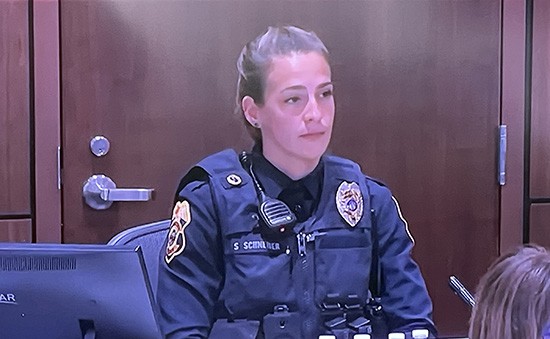
Officer Schneider did not see the car strike anyone, but she heard screaming on her radio, so she went to help. Many people told her children had been hit. Someone directed Officer Schneider to the spot where one of the Dancing Grannies lay dead, and she started working to preserve the crime scene.
When Mr. Brooks cross-examined the officer, he asked her how anyone could turn down Buckley Street, since it was barricaded. She answered, “If the vehicle were to slow down, the barricade could be moved” by police.
While the jury was on a break, Mr. Brooks cited cases on his challenge to jurisdiction. Judge Dorow said she would look at the cases he cited.
When the jury returned, Battalion Chief Jim Haakenson of the Waukesha Fire Department testified that he was at Station One when he heard an alert of a vehicle vs. pedestrian problem. On his way to the scene, he heard radio traffic about more people being hit, and he upgraded the alarm to bring more firefighters to the scene. He arrived with a fire truck and an ambulance.
Firefighters triaged patients and realized they needed help, so Chief Haakenson called for four more ambulances, another three chiefs, and another fire engine. They took 24 patients from the scene.
Mr. Brooks asked him if he was in immediate danger when he arrived at the scene. Chief Haakenson said the danger was “difficult to gauge;” he heard on radio traffic that there had been shots fired, and many people were fleeing.
On redirect, the state asked what a “Casualty Collection Point” is. Chief Haakenson said one is set up when there are many casualties, to triage patients. Patients were sent from the Casualty Collection Point to five hospitals, including a children’s hospital. Police and parade spectators also took patients to hospitals.
Nicole White, a white woman, was in the parade. A friend’s mother was with the parade and asked Miss White to walk with them and take pictures, so she was walking backwards. Mr. Brooks was driving against the direction of the parade, so anyone walking backwards would not have seen him coming. She had no warning before she was hit. “I just remember being struck by the vehicle from behind, on my back, and then I fell to my knees and rolled under the vehicle.”
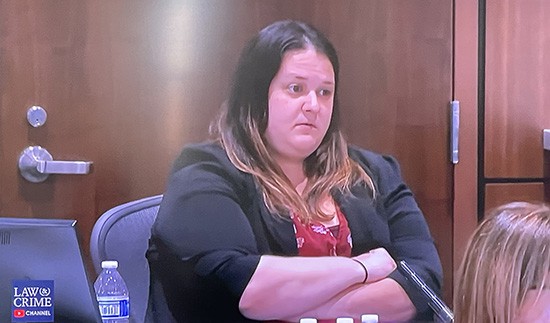
Nicole White
She thought the car would stop, but when she looked up, the red SUV veered left and kept on going. Miss White could not walk because the car rolled over her legs. Bystanders helped her get out of the street and a police officer took her to the hospital.
This was Mr. Brooks’s first cross-examination of a victim, and he was very respectful. Miss White she had not seen the driver, nor had she gotten the plate number.
Mr. Brooks asked if she filed any kind of claim. She said she filed with the state of Wisconsin to cover her medical costs, through the Victim Witness Protection program. She began trembling, but she took a deep breath and calmed down. He asked if she considered herself an injured party, and she said yes.
Sarah Wehmeier-Aparicio is the director of bands at Waukesha High School. The band marches in the parade every year; it was an event students enjoy. When she was in the high school band she marched in the parade. The prosecution showed her an aerial view of the band’s formation at the Christmas parade, labelled with the names of the children who were hurt, and she confirmed its accuracy.
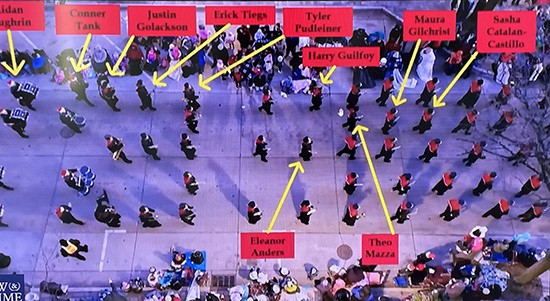
Mrs. Wehmeier-Aparicio was at the front of the band during the parade, walking backwards and facing the children. She “heard something going on” so she turned around and saw things flying in the air and she realized that it was a car hitting people. At first, she thought it was an accident, “but as I turned the car went immediately past me, and I saw that the driver was staring straight ahead, and could have clearly seen that . . . [he was] running over people.” She also said the driver did not turn his head to look for a way off the parade route.
She saw students on the ground, screaming. A policeman ran by, shouting “shots fired!” but Mrs. Wehmeier-Aparicio heard not gunfire. The uninjured students ran away.
The state showed the jury a video of the band being run over. Mr. Brooks objected a few times, trying to keep jurors from watching the video, but he was overruled. The video was paused so the band director could identify students being hit. Mr. Brooks stared intensely at the screen as he watched himself driving his car over the band members.
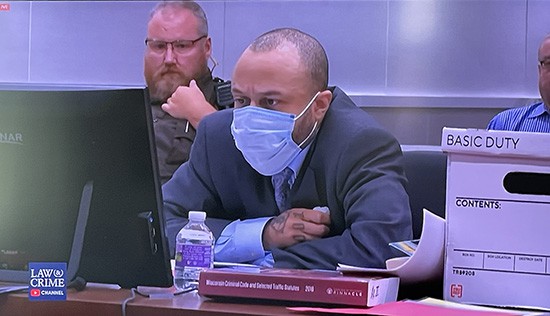
Darrell Brooks watching video of himself running over the marching band.
On cross-examination, Mrs. Wehmeier-Aparicio said she had not been injured because she moved out of the way. The first four rows of the marching band also got out of the way.
Mr. Brooks asked her if she saw news reports about the incident that may have changed her memory of it. She said the news reports did not change her memory.
Kyle Jewell brought his children to the parade. They were watching the band when he heard someone shout, “Stop that car!”
He saw the red SUV drive straight through the band, and go over people at a speed that he guessed was 30 or 40 mph. He said the SUV went up in the air, as though going over a large speed bump. The state had him clarify that the SUV was actually running over people. Mr. Jewell ran after the vehicle, to try to stop it, but it was too fast.
Mr. Brooks asked questions that damaged him. He asked what the vehicle did after it ran over the band. Mr. Jewell said, “It sped up.”
He also asked if there was any impact on Mr. Jewell or his family from having been at the parade. Neither Mr. Jewell nor his family had been injured, but he said, “There was a huge emotional impact on our family.”
With the jury out of the courtroom, Mr. Brooks consulted a law book. He wanted to ask the next witness about past convictions, which Mr. Brooks argued was relevant to credibility. Judge Dorow told him that the law would let him ask only, “Have you been convicted of a crime? If yes, how many times.”
The prosecution did not want to allow this and argued that the conviction was from 2006, and that the crime, “entry into a locked building or construction site,” was a misdemeanor, which did not imply untruthfulness.
Mr. Brooks argued, “Entering into anything is deceptive in nature.”
The judge allowed the limited questions, and Mr. Brooks asked the witness only if he had been convicted of a crime.
Thomas Greene, a white man, attended the parade with his wife and three children. He heard a crash and saw the car run over the marching band. It then swerved towards him and his family, hitting and injuring two of his children — though not seriously.
During cross examination, Mr. Brooks asked Mr. Greene what the driver looked like, and Mr. Greene used two descriptions, “dark-skinned” and “tan-skinned.” Eager to exploit any kind of inconsistency, Mr. Brooks asked, “What would you consider to be dark skinned?” “It’s hard to say,” Mr. Greene told him.
“What would you consider to be tan-skinned?”
“Darker than Caucasian, I guess,” Mr. Greene said.
Mr. Brooks unwisely asked if Mr. Greene knew what the crash he heard was. Mr. Greene said, “The vehicle hitting the band.”
Mr. Greene was the last witness, with the trial to resume the today.















